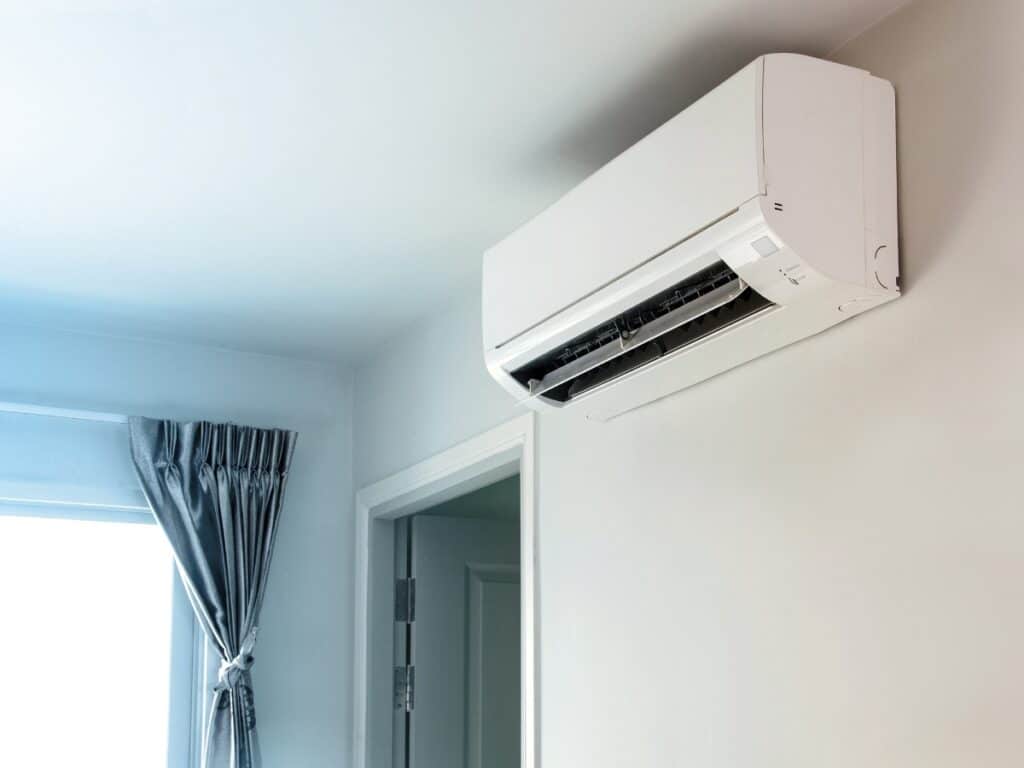Portable air conditioners have become increasingly popular as a convenient and cost-effective way to cool individual rooms. These units offer a flexible solution for homeowners who want to avoid investing in a permanent installation or who have limited window space. However, many people are concerned about using portable air conditioners in their homes.
Portable air conditioners pull warm air from the room, cool it, and then release the cooled air back into the room. They consist of a compressor, condenser coils, evaporator coils, a fan, and an exhaust hose.
Understanding Portable Air Conditioners
Portable air conditioners are versatile units that cool indoor spaces. They extract warm air and moisture through an exhaust hose, releasing cool air into the room.
It is essential to understand the difference between single-hose and dual-hose models as it impacts their cooling efficiency. Single-hose units draw in air for cooling and discharge warm air through the same hose, potentially decreasing efficiency. On the other hand, dual-hose models have a separate intake and exhaust hose for improved performance.
How Do Portable Air Conditioners Function?
Portable air conditioners draw in warm air from the room, pass it over cooling coils to remove heat and moisture, and then blow out the cooled air while expelling the hot air through an exhaust hose. This process helps cool the room efficiently.
Types of Portable Air Conditioners: Single-Hose vs. Dual-Hose
Portable air conditioners come in two primary types: single-hose and dual-hose units. Single-hose models are more common and easier to install, using one hose for intake and exhaust.
In contrast, dual-hose units have separate hoses for intake and exhaust, offering increased efficiency by not drawing in warm air from the outside. Understanding these types’ distinctions can help users choose the most suitable portable air conditioner.
Comparing Portable Air Conditioners with Other Cooling Systems
Portable air conditioners offer flexibility in cooling individual rooms, making them a convenient choice for many. In contrast, window units are semi-permanent fixtures that cool a singular space more efficiently. Central air conditioning provides whole-house cooling but is expensive to install. Unlike central systems, portable ACs need proper ventilation.
While portable units are cost-effective and easy to set up, central air conditioning systems might be less powerful. Each cooling system has its advantages and limitations regarding installation and cooling capacity.
Portable ACs vs. Window Units
Vital factors to consider when comparing portable ACs to window units are that portable air conditioners provide flexibility, as they can be moved from room to room.
On the other hand, window units are typically more efficient in cooling larger spaces due to their installation. Portable units are easier to install without permanent fixtures, while window ACs may require more effort. Understanding your specific needs and space requirements can help determine the best choice for your cooling needs.
Portable ACs vs. Central Air Conditioning
When comparing portable ACs to central air conditioning, the key differences lie in their cooling capacity and installation. Portable ACs are ideal for smaller spaces or single rooms, offering flexibility and easy setup. In contrast, central air systems are more suitable for larger homes, providing whole-house cooling but requiring professional installation.
While portable units are cost-effective and easy to move, central ACs are a long-term investment with better overall cooling efficiency. Consider your space and cooling needs to determine the best option for your home.
Safety Considerations for Portable Air Conditioners
Ventilation and exhaust are crucial for safely using portable air conditioners, ensuring hot air is effectively expelled outside. Insufficient ventilation may lead to a buildup of carbon monoxide, posing severe health risks.
Regularly check and clean the exhaust hose to prevent blockages. Place the unit on a flat surface for stability and avoid overcrowding the space around it. Prioritize safety protocols to mitigate any potential hazards associated with carbon monoxide, ensuring a secure environment for your cooling needs.
Ventilation and Exhaust: Ensuring Proper Use
When using portable air conditioners, ensuring proper ventilation and exhaust is crucial. These units extract hot air and moisture, needing a clear path to expel these elements through the exhaust hose. The unit’s cooling efficiency can decrease without adequate ventilation, leading to potential overheating issues.
Follow the manufacturer’s guidelines on venting to prevent hazards and maintain optimal performance. Proper ventilation enhances cooling and helps eliminate pollutants, ensuring a safe and comfortable indoor environment.

The Efficiency and Cost-Effectiveness of Portable Air Conditioners
Portable air conditioners offer cost-effective cooling solutions with varying energy efficiencies. Understanding a unit’s British Thermal Units (BTUs) is crucial for efficient cooling in different room sizes. Compared to central air conditioning systems, portable ACs consume less energy, making them an economical choice for smaller spaces.
Their portability adds to their value, allowing targeted cooling where needed most. When evaluating the efficiency and cost-effectiveness of portable air conditioners, consider factors like energy consumption and cooling capacity for optimal performance.
Energy Consumption of Portable ACs
Portable air conditioners have varying energy consumption levels based on their cooling capacity, measured in British Thermal Units (BTUs). Higher BTU ratings generally indicate increased energy usage. When selecting a portable AC, consider the room size to match the unit’s cooling efficiency.
Energy-efficient models benefit cost savings over time, consuming less energy while effectively cooling the space. Check the portable AC unit’s Energy Efficiency Ratio (EER) before purchase to ensure optimal energy consumption.
Cost Comparison with Other Cooling Methods
When determining the cost-effectiveness of portable air conditioners compared to other cooling methods, factors beyond the initial purchase price must be considered. While portable AC units are more affordable upfront than central air conditioning systems, they might consume more energy, leading to higher utility bills in the long run.
However, their portability and easy installation can save maintenance and installation costs. Portable air conditioners can be a cost-efficient choice for those needing temporary cooling solutions or with limited budgets.
Maintenance and Care for Portable Air Conditioners
Regular maintenance is crucial for optimal performance of portable air conditioners. Keep the unit clean by regularly dusting or vacuuming the filters to ensure efficient airflow.
Additionally, check for any leaks in the exhaust hose and seal them promptly to prevent hot air from entering the room. Be sure to follow the manufacturer’s instructions for specific care guidelines to prolong the lifespan of your portable AC. Regular care not only ensures better cooling but also helps prevent potential malfunctions. Proper maintenance is vital for a reliable cooling experience.
Benefits of Using Portable Air Conditioners
Portable air conditioners offer critical benefits, including flexibility and ease of use. They can cool specific areas, making them ideal for smaller spaces or providing spot cooling in larger rooms.
Portable AC units offer a convenient solution for those who want to avoid investing in a permanent installation. Moreover, their energy efficiency and cooling capacity make them cost-effective for maintaining comfort during warm weather. In conclusion, portable air conditioners are a versatile and efficient cooling option.
Flexibility and Ease of Use
Portable air conditioners offer unparalleled flexibility and ease of use. They allow you to cool specific areas as needed, and they can be moved from room to room, providing targeted cooling where traditional systems may not reach.
Setting up a portable AC unit is straightforward, requiring minimal installation compared to permanent systems. This convenience makes them a popular choice for renters or homeowners looking for a cost-effective cooling solution without the hassle of a complex setup.
Ideal Situations for Portable AC Use
Portable air conditioners are ideal for supplemental cooling in areas with insufficient or absent traditional HVAC systems. They excel in cooling single rooms or small spaces where permanent installation isn’t possible. These units are perfect for renters or individuals in spaces not equipped with central air conditioning.
The flexibility and cost-effectiveness of portable ACs make them convenient for specific room sizes and situations. Proper ventilation and electrical safety should always be prioritized to ensure optimal performance and minimize risks. Staying informed and following best practices will help you enjoy the benefits of portable air conditioners without compromising safety.

